Akrotiri
the famous archeological site with the excavation of the prehistoric settlement of Akrotiri.
the famous archeological site with the excavation of the prehistoric settlement of Akrotiri.
The Akrotiri fortress seems to have been built during the first Venetian century. It belongs to the same type of fortified settlements as Pyrgos and Emporio.
The Akrotiri fortress was named La Ponta and was built around a pre-existing Goulas (tower). It is first mentioned in written sources in 1336, when the Sanudo family incorporated the island to the Duchy of the Aegean, temporarily pushing aside the Barozzis. La Ponta fortress became administratively independent, as it was handed over by Niccolo Sanudo to the Gozzadinis, and remained under their rule even after the Turkish occupation.
The kasteli had a Goulas (tower) at its centre, which had existed in good condition until the earthquake of 1956. According to architect and planner Dr. Dora Monioudi Gavala*, it included a residence, along with administrative and storage areas. The details of its form followed renaissance standards: in each floor the facade was divided into equal sections by semi columns and pilasters. A window was inserted in the middle of the distance between them, there were round skylights. The nature of the fortress was strassed by the lack of openings at the base. There were also arches projecting in a row and at the entrance to the basement was crowned by a sharp angled double arch above it. The house walls at the perimeter protected the Goulas from external attacks. In the following years, the settlement was expanded beyond this defensive perimeter.
The construction of Goulades, was directly related to the social organization on the island. Powerful masters with imposing towers, like the Goulades, were distinguished from the rest of the local aristocracy which lived in Kastelia. In Kastelia and Goulades are found elements of castle architecture: the “skarpoti” form – widening base of buildings, the only entrance covered by an arc, the lack of openings in the ground floor, the strong iron doors, battlements, turrets and murder-holes.
Financially Akrotiri was the weakest area of the island. According to tax registers of the Ottoman period, the region had the greatest quantities of cotton at the expense of viniculture, among the greatest communities of the island.
In the village of Akrotiri, you should visit the remains of the Medieval castle, surrounded by some of the old traditional houses. The buildings inside the castle (as in other castelia on the island) were given to private individuals during the exchanges of land. The owner of the Goulas has restored the impressive building and since the spring of 2012 it hosts an exhibition and workshop about the hand made Greek bagpipe (www.laponta.gr).
In Akrotiri you will also see the churches of Aghia Triada, Ypapanti and Aghia Theodosia, protector of the castles.

The 3 km long asphalt road starting at the entrance of the village, will take you to the promontory at the westernmost tip of the island (it also leads to Red-Kokkini-beach). There you will see the lighthouse and enjoy the spectacular view -especially if you arrive at sunset.
Built in 1892 by a French company, the lighthouse of Akrotiri is considered one of the most beautiful in the Cyclades. The height of its tower is 10 m. It was renovated in 1925, was shut down during World War II, then resumed operation in 1945. The lighthouse was fully automated since 1988. In the south there is an anchorage protected by northerly winds.
* The information about the castle is from the book “Santorini: Society and Shelter, 15th-20th century”, by Dr Dora Monioudi-Gavala/A publication of Lukas and Evangelos Bellonias Foundation.
